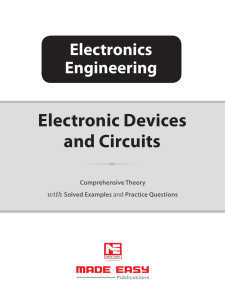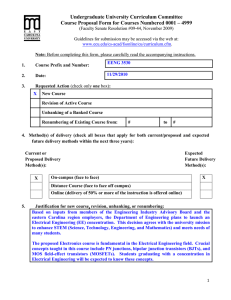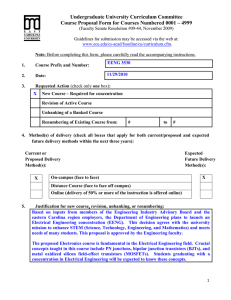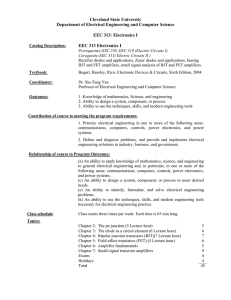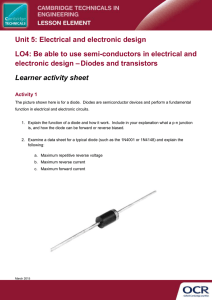EC 238 - Electronics (1)
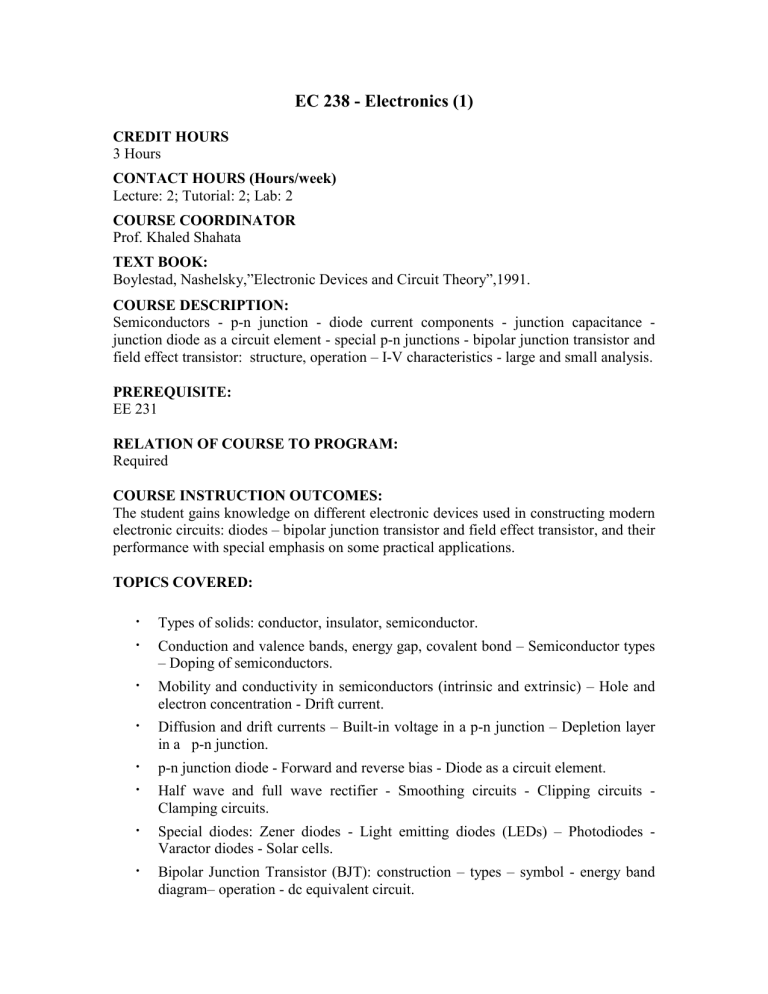
EC 238 - Electronics (1)
CREDIT HOURS
3 Hours
CONTACT HOURS (Hours/week)
Lecture: 2; Tutorial: 2; Lab: 2
COURSE COORDINATOR
Prof. Khaled Shahata
TEXT BOOK:
Boylestad, Nashelsky,”Electronic Devices and Circuit Theory”,1991.
COURSE DESCRIPTION:
Semiconductors - p-n junction - diode current components - junction capacitance - junction diode as a circuit element - special p-n junctions - bipolar junction transistor and field effect transistor: structure, operation – I-V characteristics - large and small analysis.
PREREQUISITE:
EE 231
RELATION OF COURSE TO PROGRAM:
Required
COURSE INSTRUCTION OUTCOMES:
The student gains knowledge on different electronic devices used in constructing modern electronic circuits: diodes – bipolar junction transistor and field effect transistor, and their performance with special emphasis on some practical applications.
TOPICS COVERED:
•
Types of solids: conductor, insulator, semiconductor.
•
Conduction and valence bands, energy gap, covalent bond – Semiconductor types
– Doping of semiconductors.
•
Mobility and conductivity in semiconductors (intrinsic and extrinsic) – Hole and electron concentration - Drift current.
•
Diffusion and drift currents – Built-in voltage in a p-n junction – Depletion layer in a p-n junction.
• p-n junction diode - Forward and reverse bias - Diode as a circuit element.
•
Half wave and full wave rectifier - Smoothing circuits - Clipping circuits -
Clamping circuits.
•
Special diodes: Zener diodes - Light emitting diodes (LEDs) – Photodiodes -
Varactor diodes - Solar cells.
•
Bipolar Junction Transistor (BJT): construction – types – symbol - energy band diagram– operation - dc equivalent circuit.
•
BJT: dc solution and biasing circuits - bias stability.
•
BJT: I-V Characteristics of BJT - Load line - Operating point – h-parameters.
•
BJT: Small signal analysis – ac equivalent circuit – Transistor amplifier - Voltage and current gains.
•
Field Effect Transistor (FET): (1) Junction FET (JFET): construction – symbol – operation – I-V characteristics - JFET biasing circuits.
•
Metal oxide semiconductor FET: MOSFET: construction – symbol – operation.
•
I-V Characteristics of MOSFET, Enhancement and depletion modes, E-MOSFET: construction, operation and I-V characteristics - ac solution of all FET types.
•
Complementary MOSFET (CMOS): symbol - operation - Logic gates using
CMOS.
CONTRIBUTION OF COURSE TO MEET THE REQUIREMSNTS OF CRITERION
5:
Math and Basic
Sciences
Professional Component Content
Engineering General
Topics Education
Engineering
Design
RELATIONSHIP OF COURSE TO STUDENT OUTCOMES:
Student Outcomes a. An ability to apply knowledge of mathematics, science, and engineering.
Course
Outcomes
b. An ability to design and conduct experiments, analyze and interpret data. c.
An ability to design a system, component, or process to meet desired needs within realistic constraints such as economic, environmental, social, political, ethical, health and safety, manufacturability, and sustainability. d. An ability to function on multi-disciplinary teams.
e. An ability to identify, formulate, and solve engineering problems. f. An understanding of professional and ethical responsibility. g. An ability to communicate effectively. h.
The broad education necessary to understand the impact of engineering solutions in a global, economic, environmental, and societal context i. A recognition of the need for, and an ability to engage in life-long learning. j. k.
A knowledge of contemporary issues within and outside the electrical engineering profession.
An ability to use the techniques, skills, and modern engineering tools necessary for electrical engineering practice.
